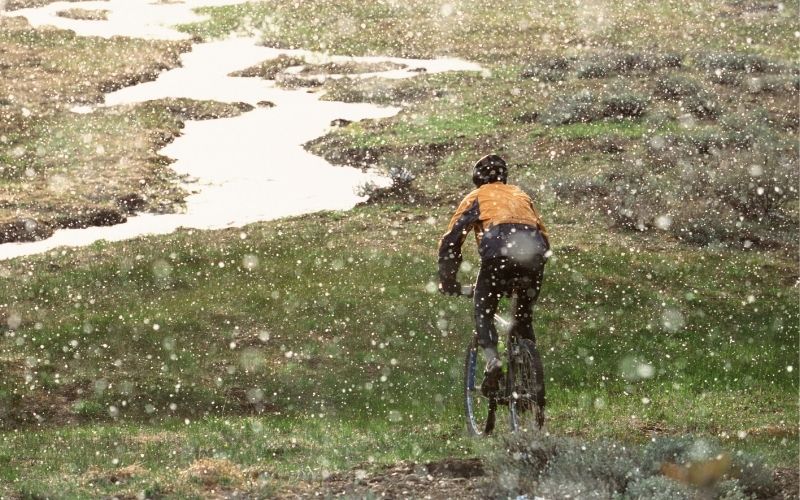Picture this: you’re riding through the mountains on your amazing mountain bike. You spent months finding the right tires with just the right amount of traction, adjusting the handlebars and seat to your liking, and deciding whether to go for a steel or carbon fiber frame.
Only 30 minutes into your ride, you feel a drop–and then another! Next thing you know it’s raining!
Should you stop your ride and take refuge under a tree until there’s absolutely no sign of rain? Or should you power through it and make the most of the weather, instead of letting it hinder your weekend ride?
A mountain bike won’t crumble in your hands the second it comes into contact with water, but there are a few things you should know before riding it in the rain.
Contents
Can a Mountain Bike Get Wet?
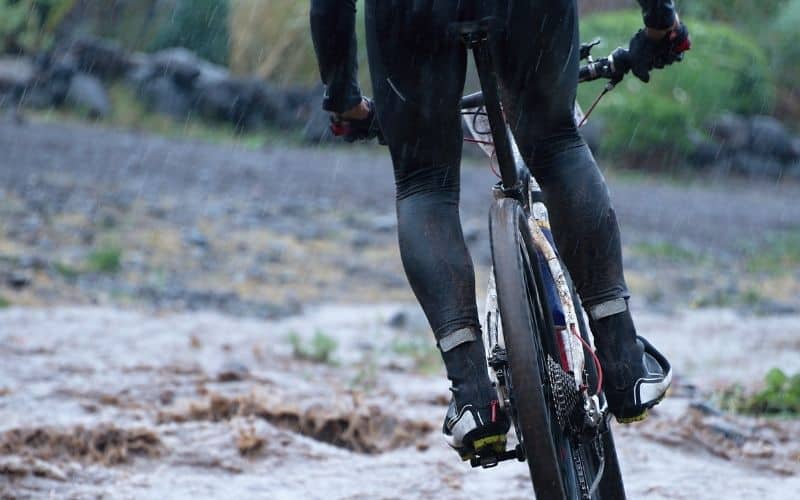
Yes! A mountain bike can definitely get wet. You shouldn’t compromise your riding journey because of a little water.
Remember, mountain bikes were designed to be ridden out in the open and deal with the wear and nature of being ridden roughly. With that being said, if you have the option to avoid riding in the rain, you should take it.
Mountain bikes don’t thrive in rainy weather. Just like what will happen if you surpass the weight limit, riding in the rain too much can affect the longevity of your bike.
Can Water Damage a Mountain Bike?
Let’s break down the ways getting your bike wet too often will affect it.
1/ Rust
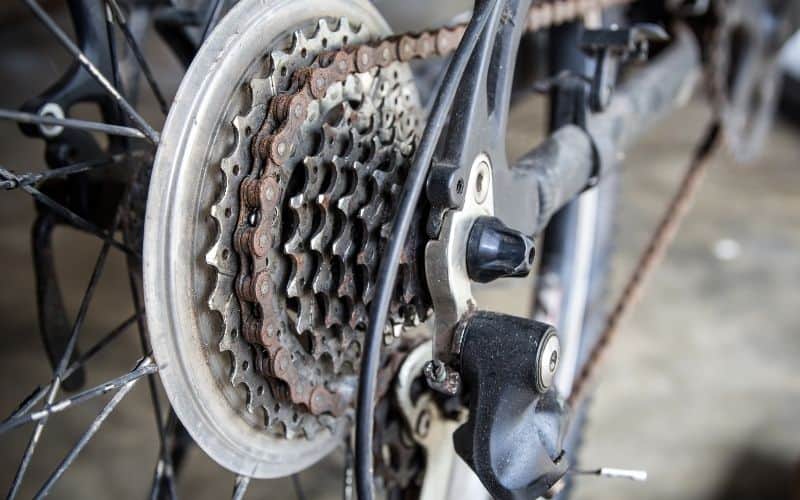
We all know metal rusts. It turns a reddish-brown color and the silky smooth exterior is quickly replaced by a rough and unpleasant coating.
Not only is rust unpleasant to look at, but it can also significantly impact your riding experience. A rusty bike is difficult to pedal, hard to brake, and challenging to maneuver. No amount of skill will make riding a rusty bike safe or easier.
If you ride on a rusty bike, you could risk hurting yourself. You may also further damage the bike itself. Luckily, a bike won’t rust immediately, so you can get away with riding it in the rain a few times. Just make sure you fully dry it off after each wet ride.
2/ General Wear and Tear
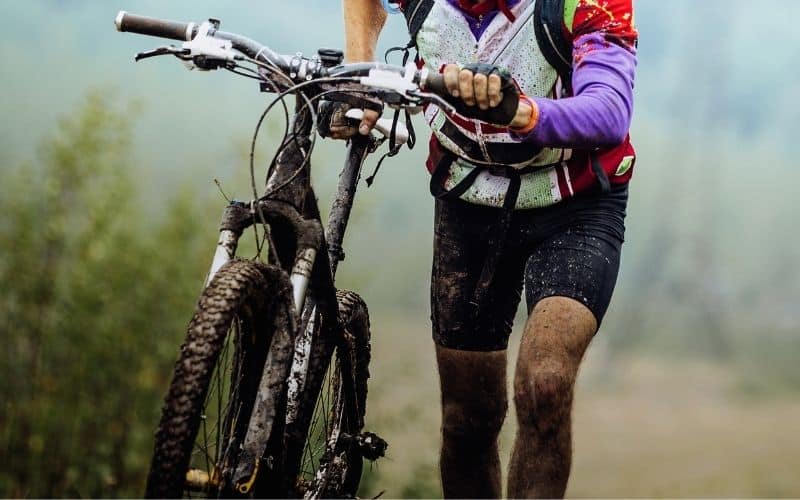
Mountain bikes are durable, but they aren’t invincible. More water means more mud and dirt as mud cakes onto your bike tires and coats the frame, your bike ages quicker.
One of the biggest ways you can maintain mountain bike tires is to clean them regularly. So, if they succumb to more grime than they normally do, and if you neglect to clean them properly, you may be shortening your tire life.
Generally, you should avoid riding on dirt or mud trails in the rain for this very reason.
3/ Danger
Getting your mountain bike wet may affect how it rides. Proceed with caution in wet weather or just after getting your bike wet.
Can I Ride My Mountain Bike in the Rain?
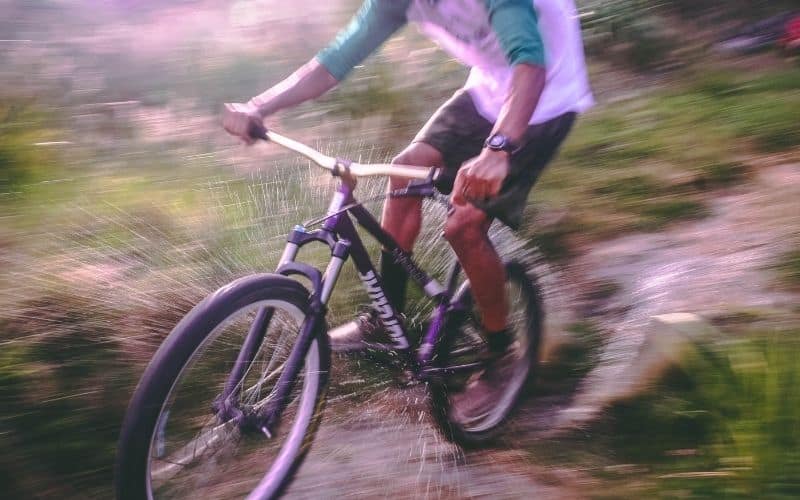
Riding in the rain is a very different experience than riding on dry ground. Beginner riders may not be ready to take their bike out in the rain since you need a solid understanding of how a mountain bike rides and how to control the brakes well.
Breaking in the rain, especially when riding in hilly or rocky areas, needs more planning. Slamming on your breaks in wet weather will not stop you as quickly as it would in dry weather.
You also need to have the right gear to ride in wet weather. This isn’t to say you need to halt your ride immediately if unanticipated rain begins to fall. If you know you’ll be riding in the rain, there are a few things you can do to prepare yourself and your bike.
It’s also important to note that rain can be a little disorientating. It can be loud, obstruct your vision, and take away the peace that many people are drawn to when riding in nature.
If you wear glasses when riding, this kind of weather can be particularly distracting.
We recommend hopping on your bike the next time it rains and riding around your residential neighborhood or to the store. Get a feel for how your bike reacts to the rain and how it looks and feels to be riding in that kind of weather.
How Do I Ride My Mountain Bike in Wet Weather?
There are several things you can do to prepare for riding a mountain bike in wet weather. If you live in an area that sees a lot of rainfall, you might want to always keep these in mind to keep your bike in good shape and your safety in check.
1/ Get the Right Kind of Tires

Mountain bike tires are often a lot thicker than road tires. This is so you can roll over rocks and debris comfortably. However, thinner tires with space between the knobs work better in wet weather.
You want as much control as possible riding in the rain, and thinner tires let you be very precise with what you ride over and what you avoid splashing into.
2/ Steering

We’re confident you know the basics of how to steer a bike, so we’ll spare you those details. However, steering in the rain is an entirely different experience.
You should be conscious of upcoming puddles on the trail. If an upcoming puddle isn’t ridiculously large, you should ride directly through it and be as centered as possible. This will protect you from slipping and getting wet.
If you come across a root or other natural obstacle in the path, you should also ride over the center of it. Remember, wet earth and roots are slippery, so you don’t want to go over something at an angle and lose your balance.
3/ Braking
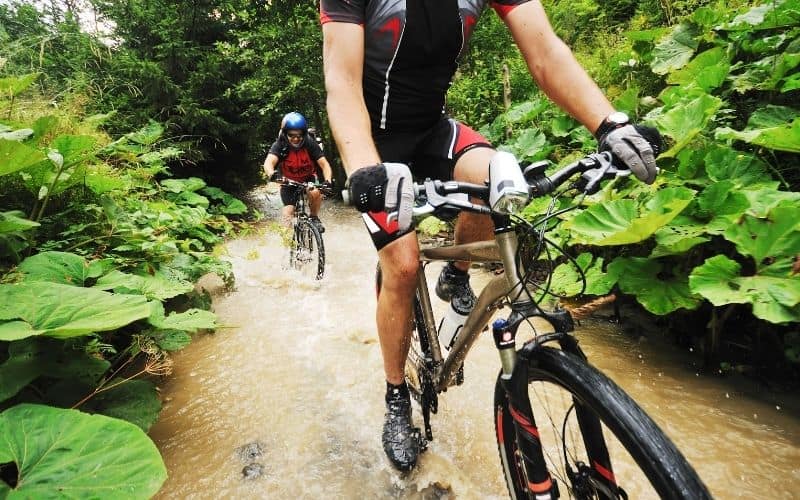
Much like when driving a car, you need to brake a lot earlier in the rain when riding a mountain bike. Remember, the traction on your wheels isn’t going to be as good in wet weather, so it will take them longer to slow down or come to a complete stop.
Wet brake pads don’t worry very well. They need to be pressed up against the rim long enough to remove any moisture before they begin braking.
Depending on the trail you’re riding, you might even want to gently apply the brakes throughout the duration of the ride. This will give you more control.
You should also be mindful of curves. Apply your brakes and slow down considerably more than you would when riding in dry weather. You do not want to slip while turning!
4/ Going Up and Down
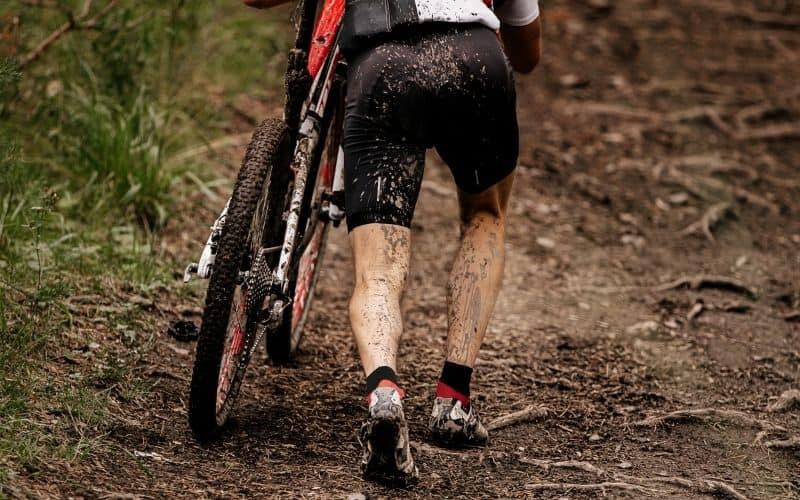
Every good mountain bike trail has some challenging inclines and declines. We all loved to be pushed, but you may want to exercise extra caution in wet weather.
When going up a hill or mountain, walking might sometimes be the best option. To start, it can be easier and ensure you don’t deplete your energy on a single incline. It may also be safer since you’ll avoid pushing even more mud into your tires.
You should be very careful when going down a hill. This can be quite dangerous, especially if you build up too much speed and can’t slow down in time. Put more weight on your back wheel if you insist on trying to ride downhill in the rain.
What Should I Do After My Mountain Bike Gets Wet?
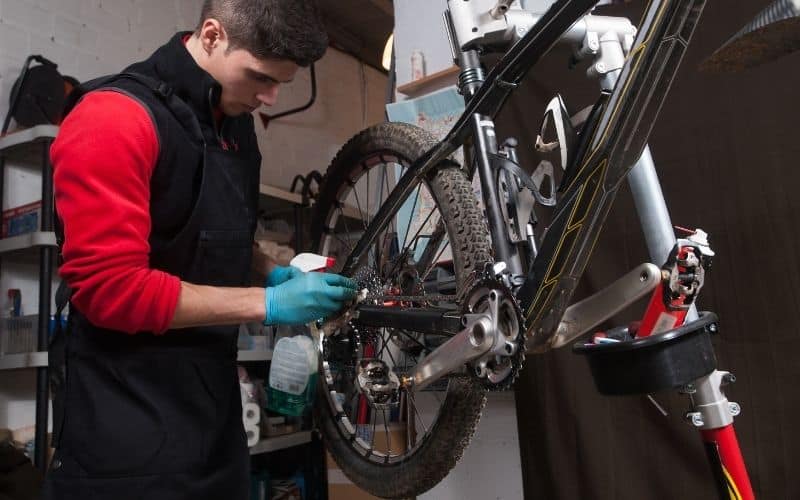
After riding through wet and muddy trails, you need to clean and dry your bike. Caked on mud will age your bike and be a lot more difficult to remove.
Clean the tires with a soft brush. Only use a rougher brush if needed. Wipe down the frame, handlebars, and pedals. Ensure there is no leftover mud on the bike.
Now grab a dry towel and focus on the areas of the bike that are prone to rust. The chains, sprockets, and discs need to be dried very well. Take your time and be thorough! How well you dry your chain could determine if it develops rust.
To Wrap Things Up
Riding in the rain isn’t going to destroy your bike, but you may not be ready for the challenge of riding in wet weather. Before attempting to enjoy a trail in the rain, make sure you have a good understanding of how your bike rides and brakes.
Rust development is one of the large risks of getting the bike wet. The best thing you can do is make sure your bike spends as little time as possible wet. We recommend carrying a towel with you to wipe the bike down.
It’s always better to go slower in the rain. Don’t worry about beating any personal records in wet weather; safety is always the priority.
Do you have any tips for riding in the rain? Do you like to hold the brakes down a little the whole time? Let us know in the comments below!
Good luck!
